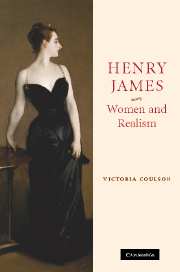Book contents
- Frontmatter
- Contents
- Acknowledgements
- List of abbreviations
- Introduction: ambivalent realism
- Chapter 1 Alice James and the portrait heroine
- Chapter 2 The actress and the orphan: Henry James's art of loss, 1882–1895
- Chapter 3 Teacups and love letters: Constance Fenimore Woolson and Henry James
- Chapter 4 Realism and interior design: Edith Wharton and Henry James
- Epilogue: 1892
- Notes
- Bibliography
- Index
Chapter 3 - Teacups and love letters: Constance Fenimore Woolson and Henry James
Published online by Cambridge University Press: 22 September 2009
- Frontmatter
- Contents
- Acknowledgements
- List of abbreviations
- Introduction: ambivalent realism
- Chapter 1 Alice James and the portrait heroine
- Chapter 2 The actress and the orphan: Henry James's art of loss, 1882–1895
- Chapter 3 Teacups and love letters: Constance Fenimore Woolson and Henry James
- Chapter 4 Realism and interior design: Edith Wharton and Henry James
- Epilogue: 1892
- Notes
- Bibliography
- Index
Summary
‘The other day,’ said Doctor Kirby, ‘happening to turn over the pages of one of these modern novels, I came upon a scene in which the hero and heroine are supposed to be shaken, tortured by the violence of their emotions, stirred to their utmost depths; and yet the author takes that opportunity to leave them there, leave them in the midst of their agonies – and the reader's as well – to remark that a butterfly flew in through the open window and hovered for a moment over their heads; … Why should the whole action of the tale pause, and at such a critical moment, in order that the flight and movement of an insignificant insect should be minutely chronicled?’
‘But, Doctor, you are attacking there one of our most cherished modern novelties,’ said Winthrop …, ‘namely, the new copartnership between Nature and Literature. Nature is now a very literary personage and a butterfly can mean a great deal.’
(Constance Fenimore Woolson, East Angels (1886), EA 150–1)Henry James wrote to W. D. Howells that he bothered to read only two contemporary English language writers: Howells himself, and Constance Fenimore Woolson. This chapter explores the work of Constance Fenimore Woolson and examines the relationships between her writing and James's, and between Constance and Henry. Woolson is an exceptional writer – sophisticated, reflective and compelling – whose work participates eloquently in the characteristic practices and preoccupations of ambivalent realism.
- Type
- Chapter
- Information
- Henry James, Women and Realism , pp. 96 - 140Publisher: Cambridge University PressPrint publication year: 2007

